RISING STORM - THE IMPERIAL JAPANESE NAVY AND
CHINA
1931-1941
 Battleship Row under Air Attack
(U. S. Navy)
Battleship Row under Air Attack
(U. S. Navy)
The Beginning of the Pacific War – The Attack on Pearl Harbor – 1941
© 2012-2013 Bob Hackett, Sander Kingsepp and Anthony Tully
Revision 1
July 1939:
The United States prohibits selling of aircraft parts to Japan.
October 1939:
The United States moves most of its Pacific fleet from Naval Base San Diego, California to Naval Base Pearl Harbor, Oahu, Territory of Hawaii.
22 September 1940:
The Japanese, in an effort to embargo all imports into China, including war supplies purchased from the United States, persuades Vichy France to cede airfields and agree to admission of up to 6,000 Japanese troops to be stationed in Vichy French Indochina (Cambodia, Laos and Vietnam).
14 January 1941:
Japan's military leaders decide on a pre-emptive attack on the United States Naval Base at Pearl Harbor. Admiral (Fleet Admiral, posthumously) Yamamoto Isoroku (former CO of AKAGI) CINC, Combined Fleet proposes an air attack on Pearl, in a letter addressed to Rear Admiral Onishi Takijiro (40), future CoS of the 11th Air Fleet. Later, the NGS approves Yamamoto's concept and planning for the attack begins shortly thereafter.
Summer 1941:
At an Imperial Conference, the planning for a pre-emptive attack on the United States is approved.
25 July 1941:
The Roosevelt Administration, citing the United States Export Control Act, places a ban on the export of steel, scrap metal and all oil exports, including aviation fuel, to Japan. The embargo hits the Imperial Japanese Navy (IJN) hard since the Navy depends on United States oil imports for 80-90 percent of its fuel. Great Britain and the Netherlands also embargo oil exports to Japan. The Naval General Staff (NGS) estimates it has less than two years of bunker oil remaining. Therefore, the IJN lends its support to existing Japanese plans to seize oil resources in the Dutch East Indies.
26 July 1941:
President Roosevelt orders a freeze on Japanese assets in the United States.
Fall 1941:
At a second Imperial Conference, authority for the attack is granted, if a diplomatic result satisfactory to Japan is not reached. During the year, pilots are trained and ships prepared for execution of the attack.
4 October 1941:
Hashirajima. A planning conference is held aboard the Combined Fleet's temporary flagship battleship MUTSU, concerning the details of the forthcoming attack on Pearl Harbor. Captain (Vice Admiral, posthumously) Harada Kaku (former CO of HOSHO) suggests to Admiral Yamamoto that top-secret two-man Type A midget submarines be used at Pearl Harbor in parallel with the air attack. Yamamoto defers a decision on the suggestion until the next day.
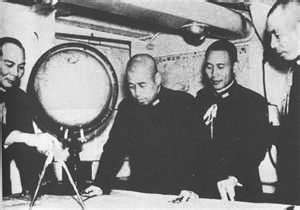 (Combined Fleet's Chief of Staff Vice Admiral Ugaki Matome (with dividers) and CinC Admiral Yamamoto)
(Combined Fleet's Chief of Staff Vice Admiral Ugaki Matome (with dividers) and CinC Admiral Yamamoto)
5 October 1941:
Captain Harada, accompanied by accompanied by midget submariner, Lt(jg) Iwasa Naoji, submits pleas to use midget submarines in the Hawaii attack directly to Admiral Yamamoto. Most air staff officers present vehemently oppose the idea.
11-13 October 1941:
Hashirajima. At another planning conference, this time aboard flagship battleship NAGATO, Admiral Yamamoto approves the use of midget submarines in the forthcoming Hawaii Operation.
19 November 1941:
At 0215, all five of the Special Attack Unit's fleet submarines (I-16, I-18, I-20, I-22 (F) and I-24) depart Kamegakubi Naval Proving Ground for the Hawaiian Islands. The mother submarines each carry a Type A midget submarine and use a direct route, but pass Wake and Midway islands at 600 nms distance to avoid detection by aircraft.
26 November 1941: Operation "Z":
Vice Admiral (Admiral, posthumously) Nagumo Chuichi's (former CO of YAMASHIRO) First Air Fleet Striking Force ("Kido Butai") departs Hitokappu Bay, Etorofu Island, Kuriles. The Striking Force consists of CarDiv 1's AKAGI and KAGA, CarDiv 2's HIRYU and SORYU and CarDiv 5's SHOKAKU and ZUIKAKU accompanied by Vice Admiral Mikawa Gunichi's (former CO of KIRISHIMA) Support Force's BatDiv 3, Section 1's HIEI and sister KIRISHIMA, CruDiv 8's TONE and CHIKUMA, DesRon 1's light cruiser ABUKUMA and her destroyers and Supply Groups No. 1 and 2.
Battleship HIEI serves as the task force's communications center, but to prevent accidental signals HIEI's radio transmission equipment is dismantled. HIEI and KIRISHIMA take up position to the rear of the Striking Force and steam eastward at 13 knots. Vice Admiral Mikawa, aboard HIEI, is designated to become the CO of the strike force in case Vice Admiral Nagumo is killed during the attack. Both HIEI and KIRISHIMA are included in the force in case some carriers are crippled and need to be towed back to Japan.
2 December 1941:
After final approval by Emperor Hirohito (Showa), the order to attack is issued.
940 miles north of Midway Island. The Striking Force receives the signal "Niitakayama nobore (Climb Mt. Niitaka) 1208" from the Combined Fleet's flagship BatDiv 1's NAGATO. It signifies that hostilities will commence on 8 December (Japan time).
7 December 1941 (Hawaiian Time): The Attack on Pearl Harbor:
At 0408, LT W. W. Outerbridge's old USS WARD (DD-139) begins a search for a suspected submarine reported by minesweeper CONDOR (AMC-14), but finds nothing.
At 0500, CruDiv 8's CHIKUMA and TONE each launch one Type 0, Aichi E13A1 Jake floatplanes for a final weather reconnaissance. TONE's Jake (coded JI-1) piloted by WO Narukawa Ryozo flies to Lahaina, but finds no American fleet units present. At 0630, CHIKUMA and TONE each launch short range Type 95, Nakajima E8N Dave two-seat float planes
to act as pickets and patrol south of the Striking Force. HIEI and KIRISHIMA also launch picket floatplanes to maintain a surface search between the "Kido Butai" and Pearl Harbor 230 miles away and for ASW patrols around the carriers.
At 0630, as Training Squadron 8's flagship 8 USS ANTARES (AKS-3) approaches Pearl's outer gate with a target raft in tow, WARD's lookouts spot a small conning tower. At 0645, WARD opens fire at 100 yards. Her first round - the first shot fired in WWII by American Forces - misses. She closes to point blank range (50 yards) and fires a 4-inch shell hitting the midget submarine's conning tower. WARD overruns her target and the midget submarine wallows in her wake. Outerbridge orders four depth charges dropped. At 0651, he signals 14th Naval District Headquarters:
"WE HAVE ATTACKED FIRED UPON AND DROPPED DEPTH CHARGES
UPON SUBMARINE OPERATING IN DEFENSIVE SEA AREA."
At 0755, the Striking Force's first wave of 189 aircraft (90 Type 97 Nakajima B5N2 Kate attack planes, 54 Type 99 Aichi D3A1 Val dive-bombers and 45 Type 0 Mitsubishi A6M2 Zeke fighters) led by Cdr (later Captain) Fuchida Mitsuo attack the U.S. Naval
Base at Pearl Harbor and other military installations on Oahu, Hawaiian Islands.
About 0840, they are followed by a second wave of 171 aircraft (54 Kates, 81 Vals and 36 Zekes) led by LtCdr Shimazaki Shigekazu. By 0945, they retire towards their carriers.
During the attacks, the Striking Force sinks the battleships USS ARIZONA (BB-39), OKLAHOMA (BB-37) and CALIFORNIA (BB-44) and damage NEVADA (BB-36), PENNSLYVANIA (BB-38), TENNESSEE (BB-43), MARYLAND (BB-46) and WEST VIRGINIA (BB-48) and other smaller ships. 2,335 American servicemen die in the attack, most on ARIZONA. After recovering all but 29 of its aircraft lost in the attack, the Striking Force departs Hawaiian waters towards Japan.

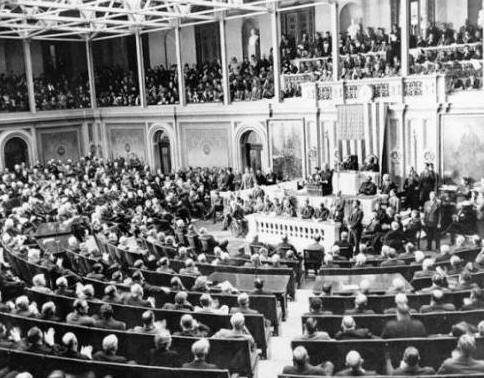 (President Roosevelt and FDR's Speech to Congress)
8 December 1941 (U.S. Eastern Standard Time):
(President Roosevelt and FDR's Speech to Congress)
8 December 1941 (U.S. Eastern Standard Time):
At 1230, President Franklin D. Roosevelt delivers a speech to a joint session of the Congress of the United States. In part, he says:
"Yesterday, December 7th, 1941 - a date which will live in infamy - the United States of America was suddenly and deliberately attacked by naval and air forces of the Empire of Japan. The United States was at peace with that nation and, at the solicitation of Japan, was still in conversation with its government and its emperor looking toward the maintenance of peace in the Pacific. Indeed, one hour after Japanese air squadrons had commenced bombing in the American island of Oahu, the Japanese ambassador to the United States and his colleagues delivered to our Secretary of State a formal reply to a recent American message. And while this reply stated that it seemed useless to continue the existing diplomatic negotiations, it contained no threat or hint of war or of armed attack. It will be recorded that the distance of Hawaii from Japan makes it obvious that the attack was deliberately planned many days or even weeks ago...
The President concludes saying "...I ask that the Congress declare that since the unprovoked and dastardly attack by Japan on Sunday, December 7th, 1941, a state of war has existed between the United States and the Japanese empire."
Within an hour Congress passes a formal declaration of war against Japan. World War II and the Pacific War begins.
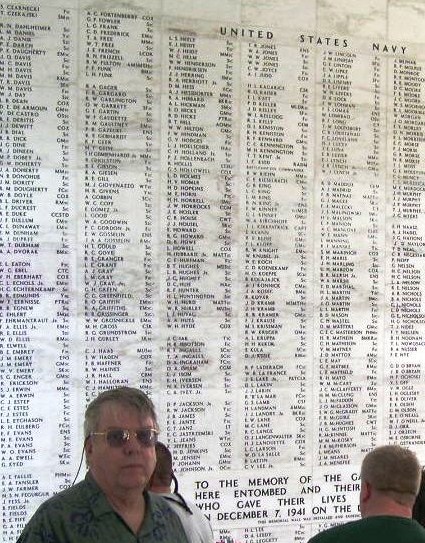
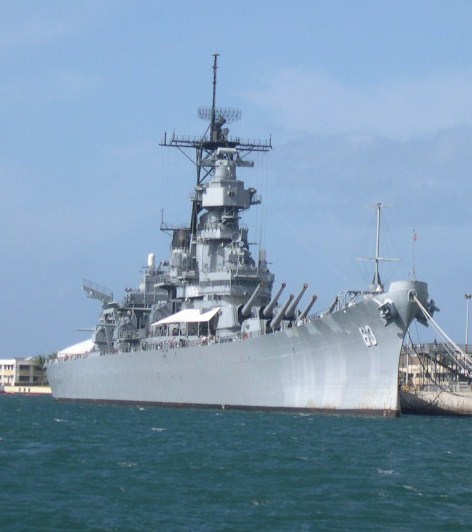
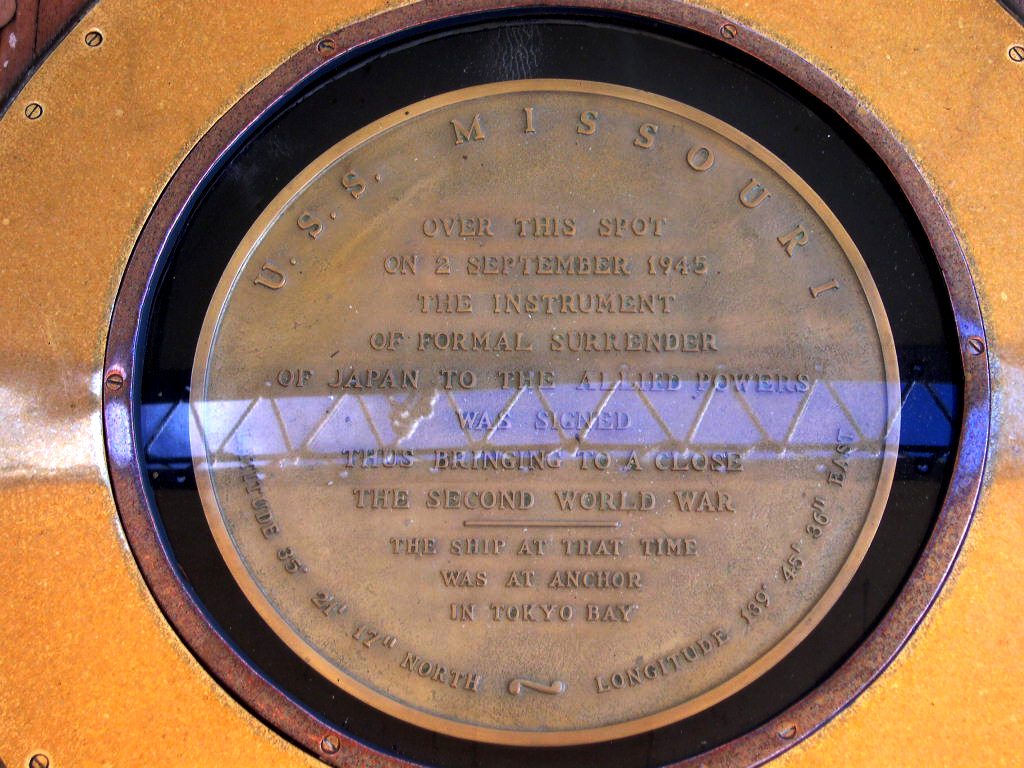 (Bob Hackett at the USS ARIZONA (BB-39) Memorial at Pearl Harbor, Honolulu, Hawaii,
(Bob Hackett at the USS ARIZONA (BB-39) Memorial at Pearl Harbor, Honolulu, Hawaii,
nearby is the USS MISSOURI (BB-63) Memorial and the plaque on her deck over which Japan Surrendered)
(Hackett collection)
That same day, the War Cabinet of His Majesty's Government authorizes the immediate declaration of war on Japan, following the Japanese attacks on Malaya, Singapore and Hong Kong. Winston Churchill, acting for the Secretary of State for Foreign Affairs, sends the following letter to the Japanese Ambassador in London:
"On the evening of December 7th His Majesty's Government in the United Kingdom learned that Japanese forces without previous warning either in the form of a declaration of war or of an ultimatum with a conditional declaration of war had attempted a landing on the coast of Malaya and bombed Singapore and Hong Kong.
In view of these wanton acts of unprovoked aggression committed in flagrant violation of International Law and particularly of Article I of the Third Hague Convention relative to the opening of hostilities, to which both Japan and the United Kingdom are parties, His Majesty's Ambassador at Tokyo has been instructed to inform the Imperial Japanese Government in the name of His Majesty's Government in the United Kingdom that a state of war exists between our two countries.
Winston S. Churchill"
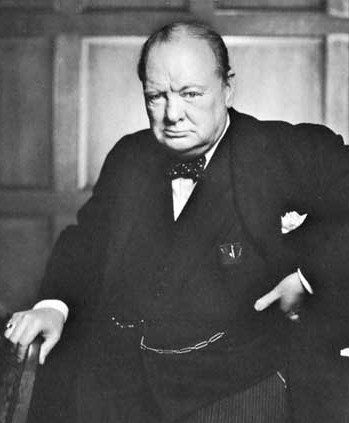
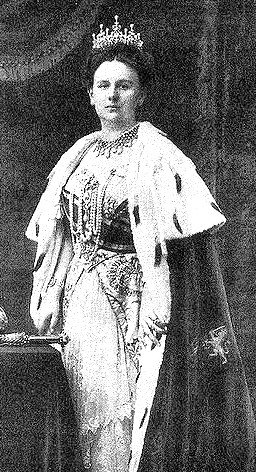
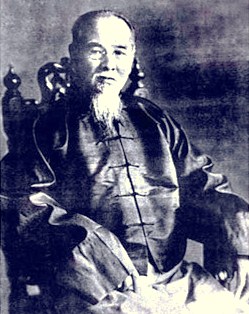 (Churchill, Queen Wilhelmina and Lin Sen)
(Churchill, Queen Wilhelmina and Lin Sen)
Also, that same day, Queen Wilhelmina of the Netherlands issues the following proclamation from London:
"The Kingdom of the Netherlands considers itself in a state of war with Japan. While negotiations which were in progress between the governments of the United States and Japan were not yet completed, and while President Roosevelt exhibited the greatest patience and did his utmost to preserve peace in the Pacific, and while an appeal which President Roosevelt had sent to the Emperor of Japan still remained unanswered, Japanese forces attacked American and British territory without a declaration of war...
Neither the safety of the territories of our Kingdom in the Far East, nor the Ties which bind us to our British Allies, nor the special relations which exist between the Netherlands and the United States allow the Government of the Kingdom to look on passively. The Kingdom of the Netherlands considers itself in a state of war with Japan because the aggression-which seeks to put out of action, one by one, the countries which desire peace-can only be halted through a strong coalition...
The Queen concludes saying "We will triumph and our Kingdom, beset but at the same time purified, steeled and standing with inviolable pride will survive stronger than ever to live under our free banner in a world free from aggression."
9 December 1941:
Lin Sen, President of the Chinese Republic issues the following declaration:
“Japan's national policy has always aimed at the domination of Asia and mastery of the Pacific. For more than four years China has resolutely resisted Japan's aggression, regardless of suffering and sacrifice, in order not only to maintain her national independence and freedom but also to uphold international law and justice and to promote world peace and human happiness…
Unfortunately Japan's aggressive capacities prove to be incorrigible. After her long and fruitless attempt to conquer China, Japan, far from showing any signs of penitence, has treacherously launched an attack on China's friends, the United States and Great Britain, thus extending the theater of her aggressive activities and making herself the arch-enemy of justice and world peace…
The Chinese Government hereby formally declares war on Japan. The Chinese Government further declares that all treaties, conventions, agreements and contracts regarding relations between China and Japan are and remain null and void.”
Japan's fate in the Sino-Japanese War is thus sealed as that war becomes a part of World War Two.
Authors' Note:
[1] Mt. Niitaka, located in Formosa (Taiwan), was then the highest point in the Japanese Empire.
-Bob Hackett, Sander Kingsepp and Tony Tully
Back to Rising Storm
Page













